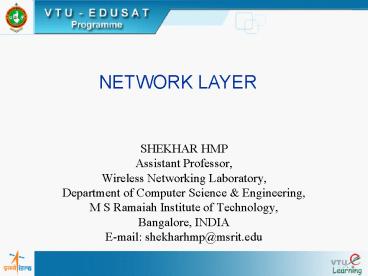SHEKHAR HMP Assistant Professor, Wireless Networking Laboratory, Department of Computer Science - PowerPoint PPT Presentation
1 / 30
Title:
SHEKHAR HMP Assistant Professor, Wireless Networking Laboratory, Department of Computer Science
Description:
RFC 1058 Split Horizon with Poisoned Reverse ... RFC 1058 Split Horizon with Poisoned Reverse. The poisoned reverse rule states that send ... – PowerPoint PPT presentation
Number of Views:157
Avg rating:3.0/5.0
Title: SHEKHAR HMP Assistant Professor, Wireless Networking Laboratory, Department of Computer Science
1
SHEKHAR HMPAssistant Professor,Wireless
Networking Laboratory,Department of Computer
Science Engineering,M S Ramaiah Institute of
Technology,Bangalore, INDIAE-mail
shekharhmp_at_msrit.edu
NETWORK LAYER
2
AGENDA
- Network Layer Design Issues
- Routing Algorithms
- Congestion Control Algorithms
- Quality of Service
- Internetworking
- Internet Protocols (IP, ARP, RARP, DHCP, etc.)
3
ROUTING ALGORITHMS
- Software responsible or deciding which output
line an incoming packet should be sent. - Done for every arriving packet (datagram subnet)
- Made only during connection setup (virtual
circuit subnet) session routing
4
ROUTING ALGORITHMS Contd.
- Router have two processes
- Routing - filling and updating of routing tables
- Forwarding looks for outgoing link in routing
table and forwards the packet
5
ROUTING ALGORITHMS Contd.
- Properties of Routing algorithm
- Correctness
- Simplicity
- Robustness
- Fairness
- Optimality
6
ROUTING ALGORITHMS Contd.
- Principle of optimality states that if a router
J is on the optimal path from router I to router
K, the optimal path from J to K also falls along
the same route.
7
ROUTING ALGORITHMS Contd.
(a) A subnet. (b) A sink tree for router B.
8
ROUTING ALGORITHMS Contd.
- Classification of Routing algorithms
- Nonadaptive or Static routing
- Adaptive or Dynamic routing
9
ROUTING ALGORITHMS Contd.
- Classification of Dynamic Routing algorithms
- Distance vector, Link state, and Hybrid routing.
- Distance vector routing RIP, IGRP
- Link state routing OSPF
10
ROUTING ALGORITHMS Contd.
- Classification of Dynamic Routing algorithms
- Interior gateway and Exterior gateway
- Interior gateway routing RIP, OSPF
- Exterior gateway - BGP
11
ROUTING ALGORITHMS Contd.
- Classification of Dynamic Routing algorithms
- Hierarchical Routing
- Broadcast Routing
- Multicast Routing
- Routing for Mobile Hosts
- Routing in Ad Hoc Networks
12
SHORTEST PATHROUTING
- Dijkstra's algorithm
- Metrics
- Number of hops
- Distance
- Delay
- Bandwidth
- Load
13
SHORTEST PATHROUTING
14
SHORTEST PATHROUTING
15
SHORTEST PATHROUTING
16
FLOODING
- Every incoming packet is sent out on every
outgoing line except the one it arrived on. - Problem too many packets
- Solution hop counter, sequence numbering
- Selective flooding
- Send incoming packets to only those lines that
are promising.
17
FLOODING
- Applications (where robustness is required)
- Military
- Distributed database applications
- Wireless LAN
18
DISTANCE VECTORROUTING
- Every router maintain a table (i.e. a vector)
which gives the best known distance to each
destination and which line to use. - Tables are updated by exchange of information
with neighbors. - Commonly known as Bellman-Ford routing and
Ford-Fulkerson algorithm. - Internet Routing Information Protocol (RIP)
19
DISTANCE VECTORROUTING
20
DISTANCE VECTORROUTING
Reacts quickly to good news
21
DISTANCE VECTORROUTING
Reacts slowly to bad news Count to Infinity
22
DISTANCE VECTORROUTING
- Solution Count to Infinity
- RFC 1058 Split Horizon with Poisoned Reverse
- The split horizon rule states that it is never
useful - to send the information about a route back in
the - direction from which it came, as the router
sending - you the information is nearer to the
destination - than you are
23
DISTANCE VECTORROUTING
- Solution Count to Infinity
- RFC 1058 Split Horizon with Poisoned Reverse
- The poisoned reverse rule states that send
- updates to neighbors with a defined hop count
- (say 16) for the routes learned by those
neighbors.
24
LINK STATEROUTING
- Each router must do the following
- Discover its neighbors, learn their network
address. - Measure the delay or cost to each of its
neighbors. - Construct a packet telling all it has just
learned. - Send this packet to all other routers.
- Compute the shortest path to every other router.
25
LINK STATEROUTING
- Learning about the neighbors
- HELLO Packets are used.
- Measuring line cost
- ECHO Packets are used.
26
LINK STATEROUTING
- Building link state packets
27
LINK STATEROUTING
- When a node receives an LSP
- Compare sequence number
- If less or equal, discard
- Else
- store new LSP
- forward on all links except the one on which it
arrived - Each node generates a new LSP periodically
- Increments sequence number
- Sequence numbers do not wrap (64 bits)
28
LINK STATEROUTING
- LSP are acknowledged
29
LINK STATEROUTING
- Computing routes
- Dijkstras shortest path algorithm
- Memory store required
- Subnet of n routers, each router with k neighbors
requires k.n - Internet OSPF
- IS-IS ( Intermediate system - Intermediate system
30
COMPARISON

